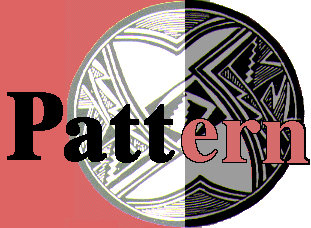
 |
Pattern Syllabus Spring 1996 |
3-26 Tues: Introduction to course, introduction to instructors and T.A., requirements (including discussion of final project), materials list, slide presentation, questionnaire. Short slide presentation, Discussion of symmetry, computation and labeling of symmetries of various mandalas, comparison of examples, triangle exercise, composition of symmetries, multiplication tables. Indian altars, c. 600 A.D. About Math 5Attendance is required and will be taken every day. More than one unexcused absence will severely damage your grade in this course. Two thirds of your grade is based on work done or due in class and one third on a final project. Homework is due the day stated and late homework will not be recorded. There is no final exam. The final project is due the last day of class. There will be no extensions of this deadline, as we anticipate needing a lot of time to grade projects properly. Furthermore, any work due after the last day of class conflicts with various regulations of the college. This class satisfies the college's quantitative requirement. This class satisfies the college's interdisciplinary requirement. No mathematics beyond high school geometry is necessary. The Final Project
Deadlines5-16 Revised proposal due. 5-22 Preview artwork for final project. 5-28 Final project due. Expect to make a short presentation.
Readings in MathDavis and Hersch: "The Classification of Finite Simple Groups." The Mathematical Experience.

ART Class, MATH 5 Pattern:Wilder l04T -TH 2:00-3:50, x period W. 4:15-5:05 Pippa DrewOffice: 206 BradleyW: 3:00 - 4:00, Tues: 4:00-5:00 The art component of this class will acquaint you with formal design elements and several approaches to the construction of two dimensional patterns. Using gouache paint, block printing methods and, of course, your own personal intuition you avid organize design elements with symmetry operations to build effective patterns. Class will be structured around particular problems, and homework assignments will be based on concepts discussed in class. Specifically, projects will focus on ways of repeating shapes, and integrating color, value and texture effectively into these patterns. The two most important goals are to recognize the form and potential of your own work through the exploration of pattern, and to use the interplav between math and art as a footing for further interdisciplinary investigation. Critiques and Portfolio Review are requirementsEvery two weeks there will be an opportunity in the x hour to review your work with others. x hours still be in 104 Wilder. Individual final portfolio reviews will be scheduled at the end of term.Grades will be based on
A few points:
SUPPLY LISTThe following supplies are available at BEANS. Dartmouth Bookstore and Dukes Art Store carry many items. Dukes and Beans provide student discount cards.GENERAL SUPPLIES2 or 3 pencils, one hard pencil for tracingeraser black sharpie or other large water proof marker. finer black marker foamcore (32 x40 ) or buy a paper portfolio at DB duck tape to make foamcore portfolios (Beans carries small rolls or share) triangle, long side, 10 inches compass 2 rulers. 18 inches. 6 inches, plastic okay scissors x-acto knife masking tape I 1/2" or 2" cheap tool case or canvas bag (don't pack art supplies with books) hammer (share) Hanover Hardware only PAINTING TOOLS:3 good brushes #3, #4, #6 rounds2 cheap brushes #8 wash, #4 or 5 rounds cheap plastic palette small covered containers. or cans for water and mixing gouache eye dropper (for adding water to gouache. Eastman s Pharmacy only) Gouache paint: (no other kind of paint please) Brands: Yarka, Winsor Newton, Pelican the small size about 1/2 ounce Yarka gouache comes In a kit with 12 colors for about $12.00. There is no turquoise or magenta. but it s the best value. You can add those two colors with other brands. You need the following colors: yellow, ultramarine, a bright true red, black, magenta or fuscia turquoise, and a large white. Winsor Newton Process White is a cheap alternative at Beans. PRINTING TOOLScutting toolsbrayer (ink roller) safety-kut blocks for printing and stamping Speed ball printing inks red, blue, yellow, white, black, magenta. turquoise small square of plexiglas free mat board scraps from Beans for mixing printing ink rags or paper towels PAPERgraph paper 8 1/2 x 11, 6 sq. /in Quadrilletracing paper 8 1/2 x 11 pad sheet of black construction paper or canson paper for first assignment An l8 by 24 pad of good drawing paper that can withstand gouache paint. It should be smoother than water color paper. Sheets of light weight Rives paper as needed for final prints (The retail person at Dukes or Beans can help you select paper) 60 to 90 lbs OPTIONALcheap colored markers or pencils for color sketchesprotractor sponge for textured printing drawing boards approx. 24 x 24, $8.35 DB mat knife portable pencil sharpener transfer paper single sheets 9 x12, $.30; 12 x18, $.50 portfolios $3.00-6.00
Readings in ArtMartinez, Benjamin and Block, Jaqueline. Visual Forces: an introduction to design 1988. 184-229.Ocvirk, Otto G. Art Fundamentals: theory and practice, 1981. Chapters 1, 2. Sousmarez, Maurice. Basic Design. The Dynamics of Visual Form, 1990. Chapter 4. On reserve: Schlain, Leonard. Art and Physics: parallel visions in space. time and light, 1990. Stevens, Peter S. Handbook of Regular Patterns: an introduction to symmetry in two dimensions, 1980. Wong, Wucius. Principles of Color Design, 1987.
|

